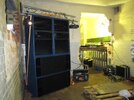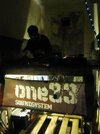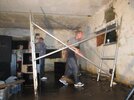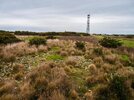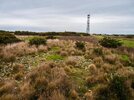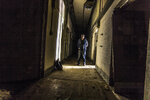“From Stettin in the Baltic, to Trieste in the Adriatic, an iron curtain has descended across the continent”
Winston Churchhill, March 1946
Towards the end of the second world war the leaders of America, Britain and the USSR - Allies against the defeted Nazi menace - met on the coast of the Black Sea to negotiate new borders across the continent of Europe. For the most part, the countries of Eastern Europe - those liberated by the Soviet Union, were brought under the totalitarian control of the communist parties with Western Europe maintaining democratic, and capitalist governance.
It was thought that peace would preside over Europe for at least a decade but during the following months the divisions between East and West quickly defined themselves and the Western leaders became increasingly suspicious of Stalin’s expansionist policies. Former allies had become foes. Churchill’s famous 1946 speech in Missouri was the first public use of the phrase ‘Iron Curtain’ and the following year US President Harry Truman committed to suppressing the communist expansion with the ‘Truman Doctrine’.
The Cold War was in full swing.
Throughout the Second World War, the main threat to Britain was invasion, but with the bombing of Hiroshima by nuclear means on the 6th of July 1945 the landscape of warfare was dramatically redrawn.
By 1949 the USSR had detonated its first atomic bomb and Britain now faced a new threat, that of nuclear weapons with the power to cause immediate devastation and leave millions dead and infrastructure debilitated.
The perceived threat was from Russian bombers carrying a nuclear payload; Near the end of World War Two some American B-29 Superfortress long range bombers had made an emergency landing in Siberia and the Russians had reverse engineered the aircraft. The TU-4 was brought into production.
The 1949 Cherry Report highlighted the risks of an air assault from the East by the TU-4 aircraft carrying freefall atomic weapons.
The report recommended a rapid redesign and improvement of the United Kingdom’s air defence systems under the program name ROTOR (Rehabilitation Of The Old Radars).
Wayne Cocroft and Roger Thomas' 'Cold War. Building for Nuclear Confrontation 1946-1989' (ISBN: 9781873592816) gives an exceptional overview of the conflict.
Operation ROTOR
At the end of WW2 the British Chain Home radar system had begun to be disassembled. Of the 200 plus stations only 36 remained on a skeleton staff.
Stage one of the ROTOR plan was to re-equip some of these stations with improved versions of equipment used in the War, codenamed Green Garlic.
RAF Ventnor was one of these sites and building commenced in 1951.
A Type 80 radar was to be positioned above ground and an underground control center to the R1 design was built and operational by 1956.
The depth of the excavation was 60 feet at it's deepest to allow for the PDU pit, where a Kelvin Hughes Photographic Display Unit sat projecting moving data from the radar onto a plotting table in the operations room above.
15000 cubic meters of concrete were pored in the construction of the 12 foot thick concrete walls and 10 foot thick floor. The bunker was waterproofed with asphalt and this was protected by brickwork and concrete slabs.
Nick McCamley's 'Cold War Secret Nuclear Bunkers' (ISBN: 8601404459801) and Nick Catford's 'Cold War Bunkers' (ISBN: 9780856440525) have a huge amount of information on the defence systems built at this time.

Site plan showing bunker from RAF archives

Plan showing an identical R1 installation at Beachy Head

A CAD model of the Type 80 merged with a modern drone shot, how the radar would have looked in 1956.
Technology rapidly expanded and with the new Linesman radar system the need for ROTOR protection became defunct. In 1959 the radar was redundant and the site passed to the Civil Aviation Authority for aircraft monitoring.
Although it had a short life the radar system and bunker exemplifies the exceptional minds and engineering prowess of the British at this time.
It still remained as a testament to the ingenuity in the face of threat that the empire had.
The CAA had no use for the underground facility and it was passed to the Isle of Wight County Council for use as a Wartime Headquarters and emergency planning locale, where the counties response to war or a disaster would be coordinated.
Duncan Campbell's 'War Plan Uk' (ISBN: 0091506719) is a tome of information on civil defence planning at this time and is highly recommended.
The bunker was decommissioned by the council in 1991, and sealed in 1994.

Cap picture in '99 - stolen from sub brit, credit to Kevin Hasler
After a few enquiries I discovered that the council had the bunker photographed shortly after decommissioning. The photographs were taken by Dave Bryan, the Isle of Wight Councils Print Unit Manager for Lt Col Ian Appleton in August 1992.
And I managed to get a cd of the photos.

Many thanks to those two people for having the foresight to document it - These haven't been published in full before and I hope they don't mind the images being used here.
The Zone
My interest, and connection with the bunker is very deep. I’ve traveled the world and put myself in some very crazy situations due to my love for exploring forgotten locations and investigating the history hidden within them - and I have this small patch of earth that first piqued my interest to thank for that.
When I was young life was all about the party and the old Chain Home radar site on St Boniface Downs was the ideal location for our hedonistic raves. Generators and Turbosound speakers, dark Drum and Bass the nastiest Techno converged with great friends in the 5 room semi buried Receiver block on top of the downs. Far from the worries and dramas of early 20’s life.
Winston Churchhill, March 1946
Towards the end of the second world war the leaders of America, Britain and the USSR - Allies against the defeted Nazi menace - met on the coast of the Black Sea to negotiate new borders across the continent of Europe. For the most part, the countries of Eastern Europe - those liberated by the Soviet Union, were brought under the totalitarian control of the communist parties with Western Europe maintaining democratic, and capitalist governance.
It was thought that peace would preside over Europe for at least a decade but during the following months the divisions between East and West quickly defined themselves and the Western leaders became increasingly suspicious of Stalin’s expansionist policies. Former allies had become foes. Churchill’s famous 1946 speech in Missouri was the first public use of the phrase ‘Iron Curtain’ and the following year US President Harry Truman committed to suppressing the communist expansion with the ‘Truman Doctrine’.
The Cold War was in full swing.
Throughout the Second World War, the main threat to Britain was invasion, but with the bombing of Hiroshima by nuclear means on the 6th of July 1945 the landscape of warfare was dramatically redrawn.
By 1949 the USSR had detonated its first atomic bomb and Britain now faced a new threat, that of nuclear weapons with the power to cause immediate devastation and leave millions dead and infrastructure debilitated.
The perceived threat was from Russian bombers carrying a nuclear payload; Near the end of World War Two some American B-29 Superfortress long range bombers had made an emergency landing in Siberia and the Russians had reverse engineered the aircraft. The TU-4 was brought into production.
The 1949 Cherry Report highlighted the risks of an air assault from the East by the TU-4 aircraft carrying freefall atomic weapons.
The report recommended a rapid redesign and improvement of the United Kingdom’s air defence systems under the program name ROTOR (Rehabilitation Of The Old Radars).
Wayne Cocroft and Roger Thomas' 'Cold War. Building for Nuclear Confrontation 1946-1989' (ISBN: 9781873592816) gives an exceptional overview of the conflict.
Operation ROTOR
At the end of WW2 the British Chain Home radar system had begun to be disassembled. Of the 200 plus stations only 36 remained on a skeleton staff.
Stage one of the ROTOR plan was to re-equip some of these stations with improved versions of equipment used in the War, codenamed Green Garlic.
RAF Ventnor was one of these sites and building commenced in 1951.
A Type 80 radar was to be positioned above ground and an underground control center to the R1 design was built and operational by 1956.
The depth of the excavation was 60 feet at it's deepest to allow for the PDU pit, where a Kelvin Hughes Photographic Display Unit sat projecting moving data from the radar onto a plotting table in the operations room above.
15000 cubic meters of concrete were pored in the construction of the 12 foot thick concrete walls and 10 foot thick floor. The bunker was waterproofed with asphalt and this was protected by brickwork and concrete slabs.
Nick McCamley's 'Cold War Secret Nuclear Bunkers' (ISBN: 8601404459801) and Nick Catford's 'Cold War Bunkers' (ISBN: 9780856440525) have a huge amount of information on the defence systems built at this time.
Site plan showing bunker from RAF archives
Plan showing an identical R1 installation at Beachy Head
A CAD model of the Type 80 merged with a modern drone shot, how the radar would have looked in 1956.
Technology rapidly expanded and with the new Linesman radar system the need for ROTOR protection became defunct. In 1959 the radar was redundant and the site passed to the Civil Aviation Authority for aircraft monitoring.
Although it had a short life the radar system and bunker exemplifies the exceptional minds and engineering prowess of the British at this time.
It still remained as a testament to the ingenuity in the face of threat that the empire had.
The CAA had no use for the underground facility and it was passed to the Isle of Wight County Council for use as a Wartime Headquarters and emergency planning locale, where the counties response to war or a disaster would be coordinated.
Duncan Campbell's 'War Plan Uk' (ISBN: 0091506719) is a tome of information on civil defence planning at this time and is highly recommended.
The bunker was decommissioned by the council in 1991, and sealed in 1994.
Cap picture in '99 - stolen from sub brit, credit to Kevin Hasler
After a few enquiries I discovered that the council had the bunker photographed shortly after decommissioning. The photographs were taken by Dave Bryan, the Isle of Wight Councils Print Unit Manager for Lt Col Ian Appleton in August 1992.
And I managed to get a cd of the photos.
Many thanks to those two people for having the foresight to document it - These haven't been published in full before and I hope they don't mind the images being used here.
The Zone
My interest, and connection with the bunker is very deep. I’ve traveled the world and put myself in some very crazy situations due to my love for exploring forgotten locations and investigating the history hidden within them - and I have this small patch of earth that first piqued my interest to thank for that.
When I was young life was all about the party and the old Chain Home radar site on St Boniface Downs was the ideal location for our hedonistic raves. Generators and Turbosound speakers, dark Drum and Bass the nastiest Techno converged with great friends in the 5 room semi buried Receiver block on top of the downs. Far from the worries and dramas of early 20’s life.
One day a friend and I, fascinated by our rave destination, decided to investigate the rumours we had heard of further underground rooms.
This was back in the first decade of the century and information was harder to come by; rumours of a 3 story underground hospital, with lifts intact abound.
The search was unguided and in the beginning fruitless, until on one late night trip to investigate these rumours we found a hole.

Another group of intrepid islanders had cracked the bounty, and when we returned from exploring the jack hammered hole, pulling our bodies though the small gap, we met them, and firm, lasting friendships were made.

The bunker was sealed when the council became aware.
The debris from the type 80 modulator building and later CAA radars piled on top of the emergency exit cap until it collapsed in a tangled mess of concrete and iron steps.
But I was hooked on the vibe and the history. In the zone.
We are now many years later, our techniques and understanding of documenting places have progressed and minds moved on to other locations.
But another couple of Islanders had got the bug. The need to crack the code and found, with such commitment and ingenuity, another way to access the bunker.
They’d asked for information and we’d given all we had; not expecting the councils efforts to seal to be minimal we were sceptical but they had the DRIVE.
Overlays of the bunker onto google earth images were a game changer and after a few digging sessions the guys hit GOLD.
Or 1950’s concrete as it happened to be.


This was back in the first decade of the century and information was harder to come by; rumours of a 3 story underground hospital, with lifts intact abound.
The search was unguided and in the beginning fruitless, until on one late night trip to investigate these rumours we found a hole.
Another group of intrepid islanders had cracked the bounty, and when we returned from exploring the jack hammered hole, pulling our bodies though the small gap, we met them, and firm, lasting friendships were made.
The bunker was sealed when the council became aware.
The debris from the type 80 modulator building and later CAA radars piled on top of the emergency exit cap until it collapsed in a tangled mess of concrete and iron steps.
But I was hooked on the vibe and the history. In the zone.
We are now many years later, our techniques and understanding of documenting places have progressed and minds moved on to other locations.
But another couple of Islanders had got the bug. The need to crack the code and found, with such commitment and ingenuity, another way to access the bunker.
They’d asked for information and we’d given all we had; not expecting the councils efforts to seal to be minimal we were sceptical but they had the DRIVE.
Overlays of the bunker onto google earth images were a game changer and after a few digging sessions the guys hit GOLD.
Or 1950’s concrete as it happened to be.
Attachments
Last edited:

